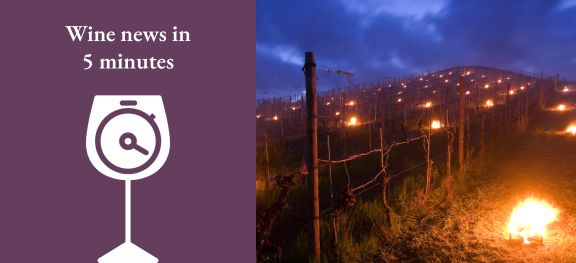Frost devastates EU vineyards, 2022 port releases, falling wine consumption

Single-quinta vintage port announcements are a rare bright spot in a week of frost reports and new data on falling consumption, production and trade. Above, fires burn in a German vineyard to keep frost at bay.
Port 2022 update and correction
I have a correction from last week. I’d said that The Fladgate Partnership owned Taylor’s, Fonseca, Croft and Krohn – but they actually sold Krohn to WineStone, a subsidiary of the José de Mello Group, last October – a piece of news that I had missed!
While I’m at it I should tell you that The Fladgate Partnership announced vintage bottlings from Fonseca Guimaraens – made in years where the classic Fonseca vintage port is not made – and from Taylor’s Quinta de Vargellas.
Additionally, the Sogevinus group announced their 2022 releases yesterday and declared four vintage ports from across their estates – Kopke Quinta S Luiz, Burmester Quinta do Arnozelo, Cálem and Barros. Going on current announcements it seems that 2022 is very unlikely to be considered a classic vintage year – though the single-quinta vintage wines (which means wines from a single estate rather than a blend of all the estates) should be very good.
Bordeaux 2023 en primeur
As you know, the 2023 bordeaux en primeur campaign is under way. James Lawther MW released his first report on our site yesterday and it suggests a fresher, more classic bordeaux style in 2023. He’ll have scores for you starting 6 May to help with buying decisions because offers are already starting to roll out, with Tanners, Lay & Wheeler, Fine & Rare and others listing in the UK. In the US, K&L in San Francisco is due to start listing within the next week, which means that J J Buckley, Zachys and others won’t be far behind!
Of course, most chateaux have not released pricing yet and, until they do, merchants will not list those wines. In terms of pricing, there seems to be a very slight reduction – Ch Batailley showed an 11.9% reduction on the price of the 2022 vintage, but there haven’t been any price drops dramatic enough to send drinkers running to buy. You can keep up to date with what’s happening in our Bordeaux EP thread and see how prices stack up against past years and against scores!
Devastating frosts
Germany was absolutely devastated by spring frost last week, during the evenings of 22–24 April. Wines of Germany reported that vines were two to four weeks ahead of average development due to an unseasonably warm spring. This means that vines were well under way with shoot growth – often with 4–5 leaves out. When temperatures dropped to as low as -5 °C, that growth, and with it most of the 2024 crop, was destroyed – often upwards of 70%. Of course, some areas were harder hit than others. While many producers attempted to mitigate the freeze with candles, it was cold enough that this didn’t always provide enough heat to stave off damage and, because the frost was so widespread, there would hardly have been enough candles or time to save everything. Nahe and Baden were particularly affected. On our forum, Klaus Peter Keller has told us that 60% of Germany has been damaged and our German wine specialist Paula Sidore has provided a few more details. Wines of Germany is regularly updating their report on the subject.
Frost also damaged French vineyards. The dates were slightly earlier: 18–23 April. Most damage occurred in the south-west – particularly in Cahors – but also in Jura, Bugey, Savoie and Provence. The French publication Vitisphère has reported that Cahors lost 90% of the crop and that 40% of Jura vineyards sustained heavy losses. In Provence, Luberon in particular was affected. Alsace and Burgundy have seen light damage in lower-elevation areas. In Burgundy the damage was in the Hautes-Côtes de Nuits and Auxey-Duresses, Monthélie and St-Aubin.
Just a reminder that in addition to the above, British Columbia, Canada, will be largely without a 2024 vintage due to freeze and Clare Valley in Australia was hit by a frost in October that affected their 2024 harvest. Thus far, 2024 is an incredibly unlucky vintage for frost and freeze.
New OIV data
Every year the International Organisation of Vine and Wine (OIV) releases data on the state of the wine industry. As you might guess, the news was not very positive in their latest release on 25 April.
According to their numbers, global wine consumption fell to 221 million hectolitres in 2023 – the lowest since 1996. This has to do with a trend towards drinking less and competition from other beverages, but it also has to do with dramatic inflation in the last two years which has increased production costs for wineries while simultaneously decreasing consumers’ buying power. EU consumption has dropped a staggering amount in the last few decades. In 2000 the EU accounted for 60% of global wine consumption; in 2023 it accounted for only 48%. China has seen an even faster decline in consumption, recording a 25% drop just last year.
In terms of categories, sparkling is, predictably, doing better than still wines, but saw only 1% growth in value and a 4% decline in volume.
While consumption isn’t doing well and exports are down in terms of volume, last year was the second highest value year for exports ever recorded – and, as exports account for 45% of wine produced, this is important. Last year the average price per litre reached a record high of €3.62 – this is a 29% increase since 2020. Notably this increase isn’t due just to the consumer trend of ‘drinking less but drinking better’; it is also because of a sharp rise in prices incurred by producers due to inflation. And if you’re thinking €3.62 a litre is cheap, remember that the wine hasn’t had duties, shipping costs or retailer mark-ups factored in. In terms of who’s importing this wine – Germany, the US and the UK maintained their positions as the top import markets.
Finally, in terms of production, 2023 saw a 9.6% decline compared with 2022 – which makes it the smallest volume of wine produced since 1961. This is largely due to frosts, floods, fires, drought and other natural disasters rather than reduced acreage – which decreased less than 1%. But, as the OIV pointed out, the fact that production is down may actually help to right the scales of supply and demand.
This is a transcript of our weekly five-minute news broadcast, which you can watch below. You can also listen to it on The JancisRobinson.com Podcast. If you have breaking news in your area, please email news@jancisrobinson.com. And if you enjoy this content and would like to see more like it, please subscribe to our site and our weekly newsletter.
Photo at top credit ZU_09 via Getty Images.
Become a member to view this article and thousands more!
- 15,399 featured articles
- 274,790 wine reviews
- Maps from The World Atlas of Wine, 8th edition (RRP £50)
- The Oxford Companion to Wine, 5th edition (RRP £50)
- Members’ forum
- 15,399 featured articles
- 274,790 wine reviews
- Maps from The World Atlas of Wine, 8th edition (RRP £50)
- The Oxford Companion to Wine, 5th edition (RRP £50)
- Members’ forum
- Commercial use of our Tasting Notes
